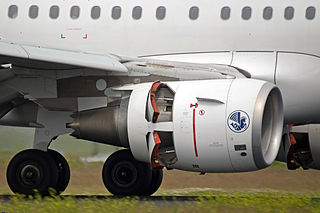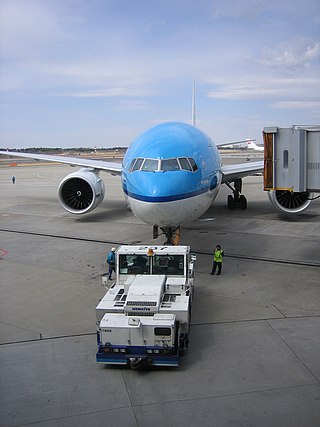Related Research Articles
The Federal Aviation Regulations (FARs) are rules prescribed by the Federal Aviation Administration (FAA) governing all aviation activities in the United States. The FARs comprise Title 14 of the Code of Federal Regulations. A wide variety of activities are regulated, such as aircraft design and maintenance, typical airline flights, pilot training activities, hot-air ballooning, lighter-than-air aircraft, human-made structure heights, obstruction lighting and marking, model rocket launches, commercial space operations, model aircraft operations, Unmanned Aircraft Systems (UAS) and kite flying. The rules are designed to promote safe aviation, protecting pilots, flight attendants, passengers and the general public from unnecessary risk.

Taxiing is the movement of an aircraft on the ground, under its own power, in contrast to towing or pushback where the aircraft is moved by a tug. The aircraft usually moves on wheels, but the term also includes aircraft with skis or floats.

United Airlines Flight 232 was a regularly scheduled United Airlines flight from Stapleton International Airport in Denver to O'Hare International Airport in Chicago, continuing to Philadelphia International Airport. On July 19, 1989, the DC-10 serving the flight crash-landed at Sioux Gateway Airport in Sioux City, Iowa, after suffering a catastrophic failure of its tail-mounted engine due to an unnoticed manufacturing defect in the engine's fan disk, which resulted in the loss of many flight controls. Of the 296 passengers and crew on board, 112 died during the accident, while 184 people survived. 13 of the passengers were uninjured. It was the deadliest single-aircraft accident in the history of United Airlines.

Thrust reversal, also called reverse thrust, is the temporary diversion of an aircraft engine's thrust for it to act against the forward travel of the aircraft, providing deceleration. Thrust reverser systems are featured on many jet aircraft to help slow down just after touch-down, reducing wear on the brakes and enabling shorter landing distances. Such devices affect the aircraft significantly and are considered important for safe operations by airlines. There have been accidents involving thrust reversal systems, including fatal ones.
In aeronautics, a descent is any time period during air travel where an aircraft decreases altitude, and is the opposite of an ascent or climb.

Centennial Airport is a public use airport owned by the Arapahoe County Public Airport Authority in the Denver-Aurora metropolitan area, 15 nautical miles southeast of downtown Denver, Colorado, United States. Located in Dove Valley, a census designated place in Arapahoe County, the airport's runways extend into Douglas County.

Pilot certification in the United States is typically required for an individual to act as a pilot-in-command of an aircraft. It is regulated by the Federal Aviation Administration (FAA), a branch of the U.S. Department of Transportation (USDOT). A pilot may be certified under 14 Code of Federal Regulations (CFR) Part 61 or 14 CFR Part 141. Pilots may also be certified under 14 CFR Part 107 for commercial drone operations.

North Las Vegas Airport is a public-use airport 3 mi (4.8 km) northwest of downtown Las Vegas in North Las Vegas, Nevada. It is owned by the Clark County Commission and operated by the Clark County Department of Aviation.

Cleveland Burke Lakefront Airport is a city-owned airport on the shore of Lake Erie, in the northeast part of downtown Cleveland, Ohio, United States. It's classified as a general aviation airport and is an FAA designated reliever to Cleveland Hopkins International Airport (CLE), which is Greater Cleveland's primary airport. In 2018, based on FAA data, Burke Lakefront was the seventh busiest airport in the state of Ohio. It is named after former Cleveland mayor and U.S. senator Thomas A. Burke.

Arkansas International Airport is a public use airport located three nautical miles (6 km) northwest of the central business district of Blytheville, a city in Mississippi County, Arkansas, United States. It is owned by the Blytheville Gosnell Regional Airport Authority.

In aviation, pushback is an airport procedure during which an aircraft is pushed backwards away from its parking position, usually at an airport gate by external power. Pushbacks are carried out by special, low-profile vehicles called pushback tractors or tugs.

Addison Airport is a public airport in Addison, in Dallas County, Texas, United States, 9 mi north of downtown Dallas. It opened in 1954 and was purchased by the town of Addison in 1976.
Corona Municipal Airport, formerly L66, is three miles northwest of Downtown Corona, serving Riverside County, California, United States. The airport has a few businesses, such as a cafe, "Flying Academy" flight training center, and aircraft maintenance and repair.

Northeast Florida Regional Airport, is located approximately four miles (6 km) north of historic St. Augustine, in St. Johns County, Florida, United States. NFRA serves as a key connection point for air travel in the Northeast Florida region. It is a public airport managed by the St. Johns County Airport Authority on behalf of the citizens of St. Johns County. Airport facilities include both commercial and general aviation terminals.
Rantoul National Aviation Center, also known as Frank Elliott Field, is a public use airport located in Rantoul, a village in Champaign County, Illinois, United States. It is owned by the Village of Rantoul.

Conroe-North Houston Regional Airport is a public-use airport in Conroe, Texas, United States, 37 miles (60 km) north of the central business district of Houston. It is publicly owned by Montgomery County.

In aviation, V-speeds are standard terms used to define airspeeds important or useful to the operation of all aircraft. These speeds are derived from data obtained by aircraft designers and manufacturers during flight testing for aircraft type-certification. Using them is considered a best practice to maximize aviation safety, aircraft performance, or both.
Fairfield County Airport is a public use airport in Fairfield County, Ohio, United States. It is located three nautical miles (6 km) northwest of the central business district of Lancaster, the county seat. The airport is owned by the Fairfield County Commissioners.

Mid-Way Regional Airport is a city-owned public airport that serves Midlothian and Waxahachie in Ellis County, Texas, United States. The airport is 5 nautical miles (9.3 km) southeast of the central business district of Midlothian.

On February 20, 2021, United Airlines Flight 328 (UA328/UAL328), a scheduled U.S. domestic passenger flight from Denver to Honolulu, suffered what was technically ruled a contained engine failure despite shedding large pieces of debris, approximately four minutes after takeoff from Denver International Airport (DEN). Parts departing from the engine cowling of the Boeing 777-222 aircraft resulted in a debris field at least 1 mile (1.6 km) long over suburban residential areas of Broomfield, Colorado. Falling debris was recorded by eyewitnesses using smartphone cameras and a dash cam. Debris fell through the roof of a private home and significantly damaged a parked vehicle.
References
- ↑ Transport Research Board of the National Academies, "Airport Passenger Terminal Planning and Design: Guidebook" . ACRP report 25. Airport passenger terminal planning and design. Volume 1:Guidebook. page 128. 2010. ISBN 978-0-309-11820-0
- ↑ Lim Khoy Hing (2017-11-01). "Pilot's Perspective: Staying the Course". travel360.com.
- 1 2 John Cox (2019-03-08). "Ask the Captain: Why don't airplanes 'power back' from the gate?". USA Today.
- ↑ Penris, Renee (2017-07-14). "5 Airplane Mysteries You Didn't Know You Wanted To Know". blog.klm.com.
- ↑ "CHAPTER 18 OPERATIONS SPECIFICATIONS - Section 5 Part C Operations Specifications—Airplane Terminal Instrument Procedures and Airport Authorizations and Limitations (OPSPEC C065)". faa.gov.
- ↑ "C-130 powerback using reverse thrust". Youtube. Archived from the original on 2021-12-21.
- ↑ "C-5M Super Galaxy Power Back". Youtube. Archived from the original on 2021-12-21.
- ↑ "C-17 Reverse Thrust - Backing Up, Departure & Arrival". Youtube. Archived from the original on 2021-12-21.